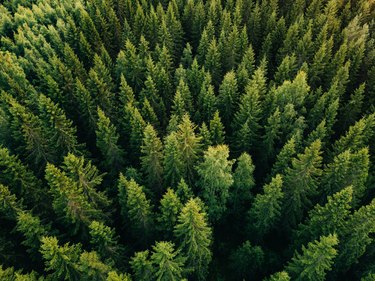
There can be many culprits if a pine tree is turning yellow, but sometimes, the cause is natural and nothing to worry about. Even though pine trees (Pinus spp.) are evergreen coniferous trees, they still drop needles regularly as the needles get older. Watering issues, damage and pests can also cause pine trees to turn yellow. Examining the location and type of needle yellowing helps you determine the cause and find a solution.
Normal Seasonal Needle Loss
Video of the Day
Older pine needles on the interior of many types of pine trees turn yellow naturally. They typically then turn reddish-brown and eventually fall off the tree. This cause of pine trees turning yellow typically happens in the fall. If you think the needles are turning yellow due to natural aging, you don't need to do anything for your tree.
Video of the Day
Too Much Water
Pine trees appreciate a good drink, especially during periods of drought, but too much water can cause yellowing needles. When you overwater your pine, the roots can't get the oxygen they need. If you're overwatering, you'll likely see yellow needles and droopiness.
Hold off on watering if you think this is the issue. You can use a soil moisture meter to check the soil around the tree or insert your finger into the soil to see if it feels saturated to a few inches deep. Let the soil dry out slightly before watering again.
Winter Sun Scald
In the winter, your pine trees are susceptible to sun scald due to the environmental conditions. The combination of dry air, winter winds and low soil moisture can make the tree more susceptible to intense winter sun. You'll likely only see the yellowing on one side of the tree where it's most exposed to the winter winds. The yellowing mainly affects the tips of the tree branches with the interior needles staying sheltered.
Sun scald usually corrects itself in time, but the yellowing will likely last until the next season. You can cut down on the risk of sun scald by watering your pine tree once or twice per month when the temperature remains above 40 degrees Fahrenheit.
Pine Tree Freeze Damage
Another winter threat for pine trees that can cause yellowing is freeze damage. This most often happens when there's a sudden temperature drop causing a sudden hard freeze when temperatures were previously warm. The major temperature swing doesn't give the pine tree enough time to go through its natural metabolic processes that protect it from the cold. Freeze damage typically causes yellowing just at the tips on all sides of the tree.
Since you can't control the weather, there's usually not much you can do to prevent freeze damage. Your pine tree will often return to a healthy state on its own. You might need to grab pruning tools and remove damaged parts of the pine tree in the spring.
Pine Wilt Disease
Pine wilt disease, caused by the pine wood nematode, can cause the pine needles to change to an off-green or yellowish color. Once the needles die, they hang onto the tree for a long time. Scotch pines (Pinus sylvestris, USDA zones 2-) are particularly susceptible to this condition.
Once infected, the pine tree will die, often within months. If your pine tree is large, it could hang on for a year or two. There's no way to cure the disease, but removing and disposing of a pine tree infected with pine wilt can prevent it from spreading to other pines.
Pine Tree Mite Damage
Some insects can result in pine trees turning yellow. Spider mites are one common example because they suck out the chlorophyll that makes the needles green. If mites are to blame, you'll likely see yellow stippling, or spots, on the pine needles. When heavily infested, the tree might lose needles, and you might notice fine webbing on the stems.
If your pine tree is still small, you might be able to spray the tree with water to wash away the mites. Insecticidal soap can help control spider mites in your pine trees if the infestation is more severe. Pine trees are more susceptible to mites in droughtlike conditions, so a layer of mulch can help keep your tree healthy and a little more resistant to mites.